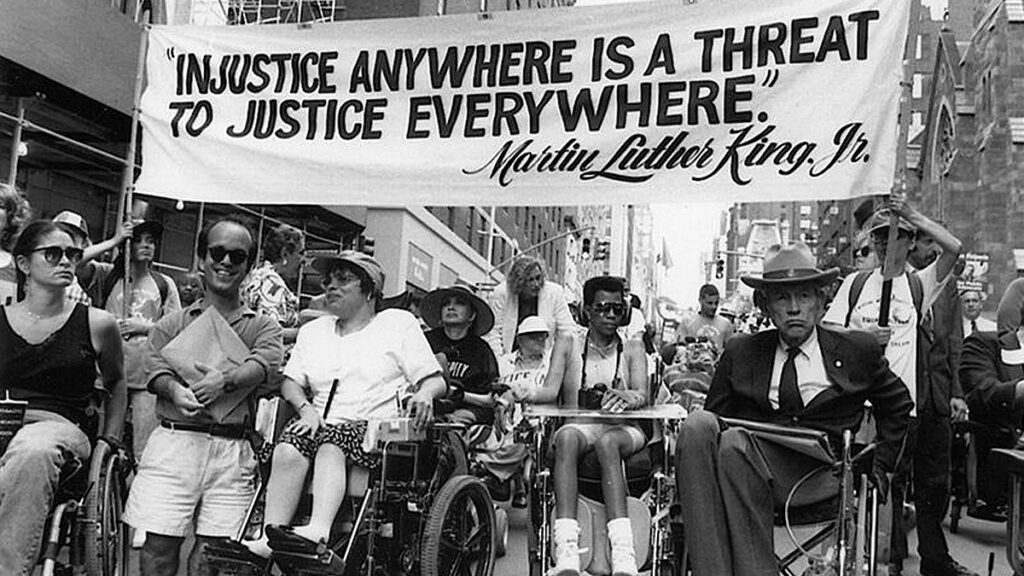By Menachem Rephun, Creative Spirit Communication Manager

Since its beginnings in the early 19th century with efforts to provide formal education for deaf and deaf-blind individuals, the disability rights movement has worked to achieve inclusion and societal acceptance, shatter stigmas, and expand recognition that individuals with disabilities are human beings deserving of the same dignity and respect as the non-disabled population. As with all efforts to achieve lasting change, the movement has seen its share of turbulence, as activists and allies campaigned and fought, often at great personal expense, to ensure civil rights for the roughly 61 million Americans with disabilities. In this article, we’ll explore 5 historic moments and milestones that shaped and defined the disability rights movement, improving independence and accessibility for people with disabilities today.
Education Rights and Parent Advocacy
While the 1990 Americans With Disabilities Act (ADA) is arguably the most groundbreaking piece of legislation protecting the rights of people with disabilities in the U.S., it was not the first. One of the most noteworthy pre-ADA legislative efforts was the Education for All Handicapped Children Act, now known as the Individuals With Disabilities Education Act (IDEA) of 1975, which required federally funded public schools to provide equal educational access for children with disabilities, as well as one free meal per day. This legislation was significant due to the connection between education and fair-wage employment, as Pat Wright, disability rights activist and co-founder of the Disability Rights Education and Defense Fund (DREF), has noted.
“If you don’t have an education, we can’t get you to get a job,” Wright was quoted as saying by the New York Times. “We can’t have you participate in society. If you don’t have transportation, you can’t get back and forth to your job. So each one of those things that nondisabled kids take for granted become the linchpin of people with disabilities’ lives.” The IDEA was also a watershed moment in that, prior to its passage, only 1 in 5 children with disabilities were educated in U.S. schools. According to American Constitution Society Law.org, this means that roughly 1 million children with disabilities were receiving no education from the public school system. Even worse, many states had laws explicitly excluding students with physical and developmental disabilities from the classroom. As the NY Times notes, the IDEA was passed after parents filed several lawsuits referring to the landmark 1954 Supreme Court ruling “Brown v. Board of Education”, which established racial segregation in schools as unconstitutional, arguing that the same inequality was being extended to students with disabilities. As IDEA’s website notes, “Since 1975, we have progressed from excluding nearly 1.8 million children with disabilities from public schools to providing special education and related services designed to meet their individual needs to more than 7.5 million children with disabilities in 2020-21.” You can learn more about IDEA here: https://sites.ed.gov/idea/.
The 504 Sit-Ins
In our recent article on Black leaders of the disability rights movement, we discussed the historic 504 Sit-In, a pivotal moment that laid the groundwork for the passage of the ADA. Beginning on April 5, 1977, disability rights activists demonstrated at federal buildings in Boston, Seattle, New York, Atlanta, Philadelphia, Chicago, Dallas, San Francisco, Denver, and Washington, D.C to demand the signing of regulations enforcing Section 504 of the 1973 Rehabilitation Act, which would protect people with disabilities from being excluded or discriminated against “under any program or activity receiving federal financial assistance,” i.e. libraries, schools, courtrooms, public transportation, and many other vital resources. The demonstrations were the result of frustration that reached a boiling point when Health, Education, and Welfare (HEW) Secretary Joseph Califano established a task force to study the 504 regulations that failed to include a single member with a disability.
The most noteworthy of the protests (most of the others lasted only 24 hours or less) took place in San Francisco, where over 100 demonstrators occupied the HEW offices for 25 days, making it the longest sit-in at a federal building in U.S. history. The 504 Sit-In would prove to be historic not only for the basic rights it protected, but for its positive impact on society’s view of people with disabilities. In the words of famed disability rights activist Kitty Cone, a lead organizer and strategist behind the Sit-In (along with her colleague, the late Judy Heumann), the demonstrations signified “the public birth of the disability rights movement”, shifting the public perspective on disability towards societal responsibility, rather than forcing people with disabilities to fend for themselves. “Before section 504, responsibility for the consequences of disability rested only on the shoulders of the person with a disability rather than being understood as a societal responsibility,” Cone wrote in an overview of the 504 Sit-In. “Section 504 dramatically changed that societal and legal perception.” Cone added that without Section 504 and the disability civil rights principles contained in its regulations, “There might well be no Americans with Disabilities Act, that finally brought us up to parity with federal civil rights laws covering gender and race.” She also credited the 504 Sit-In with giving people with disabilities “a new sense of pride, strength, community, and confidence.” The sit-in generated enormous media attention, as well as wide-reaching empathy and assistance, with food donated by local grocery chains, the Black Panthers, and many others, including Senators, Congressmen, and San Francisco Mayor George Moscone. On April 28, the demonstrators’ efforts finally prevailed, as Califano signed the 504 regulations in their original, uncompromised form, a crucial point the protestors had fought hard for. As DREDF.org explains, 504 established “the right of an individual who has experienced discrimination to pursue an administrative remedy with the appropriate federal agency as well as to go to court.” You can read Kitty Cone’s essay reflecting on the Sit-In and its impact here: https://dredf.org/504-sit-in-20th-anniversary/short-history-of-the-504-sit-in/.
The Capitol Crawl
In 1990, thirteen years after the 504 Sit-In achieved groundbreaking disability rights reforms during the Disability Rights Movement, another equally important and powerful public demonstration took place that improved representation for people with disabilities and ensured the passage of the ADA. Dubbed “the Capitol Crawl”, the demonstration began on March 12, 1990, when over 1,000 people marched from the White House to the U.S. Capitol to demand the immediate passage of the ADA. Upon arriving, around 60 of the demonstrators discarded their wheelchairs and other mobility aids and began crawling up the 78 steps of the Capitol. The crawl was preceded by an impassioned speech from activist Mike Auberger, who pointed out that “the preamble of the Constitution does not say: “We the able-bodied people. It says “We the People.” This declaration was an agreed-upon cue for the protesters connected with Americans Disabled for Accessible Public Transit (ADAPT), the disability rights organization that had helped organize the protest, who immediately began their climb up the Capitol steps. They were soon joined by others who had not known that the crawl was pre-planned. The message was direct and clear: people with disabilities were still heavily impacted by physical inaccessibility in everyday life, and passing the ADA was absolutely essential.
“Some people may have thought it was undignified for people in wheelchairs to crawl in that manner,” Michael Winter, former Executive Director of the Berkeley Center for Independent Living, later reflected. “But I felt that it was necessary to show the country what kinds of things people with disabilities have to face on a day-to-day basis. We had to be willing to fight for what we believed in.” One of the participants who demonstrated that point the most movingly and unforgettably was Jennifer Keelan-Chaffins, an eight year old from Colorado diagnosed with cerebral palsy at age two. Despite her young age, Keelan-Chaffins had already been protesting for two years, starting with an ADAPT protest in Phoenix advocating for accessible busing for people with disabilities. Speaking to a crowd of reporters during the Capitol Crawl demonstration, Keelan-Chaffins expressed her determination to climb all of the Capitol steps. “I’ll take all night if I have to!” she declared. Still, some of the adult demonstrators were hesitant about whether Keelan-Chaffins should climb the steps of the Capitol, out of concern that the image of a child with a physical disability doing so might provoke pity, rather than the message of empowerment they were seeking to convey. Reverend Wade Blank, founder of ADAPT, thought otherwise. He encouraged Keelan-Chaffins to climb the steps if she wanted to. Speaking to History.com many years later, Keelan-Chaffins said that despite her young age at the time, she still had a sense of herself as a small part of a much larger movement. “I realized that as one of the very few kids that got to be involved in this movement…it wasn’t just about myself but it was about them as well,” she said. In addition to her own enthusiasm and determination, Keelan-Chaffins recalls receiving generous and enthusiastic support from the other bystanders and participants that day.
“As I got further and further up the steps, once people realized that I was actually climbing and participating in the Capitol Crawl, all I could hear was this humongous roar of cheering,” Keelan-Chaffins told ABC News in 2020. “Of people cheering me on, telling me that I can — that I’ll be able to make it. That I can, you know, just take one step at a time.” The demonstration proved to be successful, and the ADA was signed into law by then-President George H.W. Bush just four months later, on July 26, 1990. The Capitol Crawl demonstrated to millions of Americans the accessibility challenges experienced by their fellow citizens with disabilities, and the power that individuals of any age have, through courage and determination, to truly make a difference.
Founding of ADAPT
In the decades leading up to the passage of the ADA, the inaccessibility of public transportation and public spaces in general had long presented one of the most serious challenges for the millions of Americans with disabilities. For individuals utilizing wheelchairs or other mobility aids, riding buses or navigating steps demanded strenuous effort. Even worse, public businesses and services, such as restaurants and even grocery stores, were legally allowed to prevent people with disabilities from eating or shopping there. This blatant discrimination and lack of basic accessibility led to the founding, in 1983, of Americans With Disabilities for Accessible Transportation (ADAPT), an organization which, as mentioned previously, helped organize the “Capitol Crawl” which in turn ensured the passage of the ADA. More specifically, the founding of ADAPT was inspired by a protest in Denver, Colorado in 1978, in which 19 activists (dubbed “The Gang of 19”) with physical disabilities left their wheelchairs and blocked two inaccessible city buses to protest the physical inaccessibility of Denver’s public transit system. The protestors continued blocking the intersection all day and night, chanting “We Will Ride!” until they were finally given the opportunity to speak with representatives of the Regional Transportation District (RTD) about ensuring that public buses were wheelchair accessible. As a retrospective by the Denver Post explains, the protest signified “a turning point, with some calling it the shot heard around the world…people with disabilities were willing to get arrested for their rights.” As expressed by the ADAPT website (ADAPT now stands for “Americans Disabled for Attendant Programs Today”), “Many might think it is a tragedy to acquire or be diagnosed with a disability; it isn’t. The tragedy is when we are denied our civil rights, our dignity and our right to choice. This is what fuels our righteous efforts.” Through those efforts, which are still ongoing, ADAPT has had an enormous impact on disability rights, and contributed to the passage of the ADA. You can learn more about ADAPT’s mission and history here: https://atlantiscommunity.org/about-us/history-of-atlantis-adapt/.
Disability Pride
Promoting a strong sense of pride and community for people with disabilities has been central to the disability rights movement since its inception. This perspective was expressed decisively in 1990, when Massachusetts held the first ever disability pride parade, coinciding with the passage of the ADA. The events became more frequent after Chicago held its own first pride parade fourteen years later, in 2004. In 2015, the first official disability pride celebration was held in New York City to commemorate the anniversary of the ADA. But what does “disability pride” actually mean? According to disability advocacy organization EasterSeals, the concept of disability pride emerged as a direct response to negative perceptions of disability.
“Many people view their disability as an integral part of who they are, rather than a flaw or something that should be separated from their identity,” the organization states on its website. “Disabled people (or people with disabilities — more on terminology later) are sometimes framed by society as pitiable or helpless, waiting for a cure to solve any problems they may have. This view of disabled people damages confidence and self- esteem, especially since ableism (discrimination against people with disabilities) is so prevalent.” In short, disability pride counteracts views of disability that have historically harmed both self-esteem and equal treatment and access to vital services. Jessica Ping-Wild, an American disability rights blogger and advocate, described disability pride as “a chance for disabled people to declare their inherent self-worth, something that isn’t often done by individuals outside of the community.” While Disability Pride emphasizes that having a disability is not only nothing to be ashamed of, but in many cases can even give a person unique strengths and talents, it is also significant in allowing people with disabilities to express the fact that that they are not defined solely by their respective conditions, and that they are individuals who deserve to be treated with the same dignity and basic humanity as others. From the 504 Sit Ins, to the Capitol Crawl, to the passage of the ADA, the underlying message of the disability rights movement has been a call for action for society to finally respect the dignity of people with disabilities, appreciating them as human beings and distinct individuals. The movement has consistently driven home the point that a free and fair society must include the millions of Americans with disabilities in the Constitutional declaration that all people are created equal, and that they deserve to be protected against unlawful discrimination and exclusion in schools, in employment, and in public transportation. Creative Spirit is continuing to do our part in advancing that vital message. The determination, courage, and resilience of people like Judy Heumann, Jennifer Keelan-Chaffins, and many others serves as a guiding light as we connect our candidates with fair-wage employment at companies that appreciate the creativity and innovation people with disabilities can contribute.






